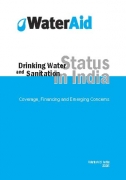Drinking and other Domestic Uses
Right to water and sanitation - A draft paper by WaterAid
Posted on 05 Jun, 2009 11:54 AM"Right to Water and Sanitation", is a briefing paper (draft) written in March 2009, by Indira Khurana and Richard Mahapatra of WaterAid India, based on secondary research.
Symbiosis institute of design, Pune, receives first prize for the presentation on water management in low income housing colony in the city
Posted on 04 Jun, 2009 04:19 PMA portable bicycle pump reduces the drudgery of transporting water to these homes. They also plan to implement grey and black water treatment systems with the assistance of industries in the vicinity that can use that water, or use the sewage waste to generate biogas.
Report of steering committee on drinking water supply and sanitation for tenth five year plan and report of working group on natural resource management and water resources for 11th five year plan
Posted on 02 Jun, 2009 02:29 PMReport of steering committee on drinking water supply and sanitation for tenth five year plan
Review of drinking water and sanitation status in India - A report by WaterAid India
Posted on 02 Jun, 2009 12:40 PM This paper by WaterAid India is an assessment of the drinking water and sanitation situation in the country in terms of coverage and financing gaps, if any, keeping the targets of the Millennium Development Goals as a benchmark for the assessment.
This paper by WaterAid India is an assessment of the drinking water and sanitation situation in the country in terms of coverage and financing gaps, if any, keeping the targets of the Millennium Development Goals as a benchmark for the assessment.
Water quality in various areas of Delhi: survey results of the Clean India Campaign
Posted on 02 Jun, 2009 10:43 AMDevelopment Alternatives did a survey of water quality in various areas of Delhi through its Clean India Campaign. The results are presented as a software application. The application can be downloaded and installed on your computer.
Debate - Private sector approaches to water management for the poor
Posted on 02 Jun, 2009 10:20 AM"Innovations in Microfinance" Series
A debate on Private Sector approaches to Water Management for the poor provides a unique opportunity to learn about private sectro microfinance approaches to water management that have been used for a range of purposes from purchasing household water connections and clean water storage units, like rainwater harvesting tanks to the construction of household latrines.
The debate sponsored by the Citi Foundation & Arc Finance is to be held at the New York Asia Society and Museum. The event can also be accessed via a free live video webcast. More details below the fold.
Approximately 1.1 billion people lack clean water supplies and 2.7 billion have no access to proper sanitation. To combat conditions that lead to sickness and disease, low income families across Asia are asking for clean water and improved sanitation to keep their families healthy and productive. Sophisticated modern piped water networks are too expensive for most developing countries and poor people living in the slums often pay 5 to 10 times more per liter of water than wealthy people living in the same city. Sensing a business opportunity, microfinance organizations are beginning to explore the market for making water more accessible to the poor.
District human development report card for 10 districts- the PAHELI report
Posted on 01 Jun, 2009 03:46 PMThe PAHELI report (Peoples' Audit of Health Education and Livelihoods) is a rapid assessment of the prevailing status of human development in a district and covers four major sectors: life and livelihoods, water and sanitation, mother and child health, and education and literacy. The design and execution of PAHELI was done by Pratham and PAHELI district partners.
The ninth compendium of environment statistics by ministry of statistics and programme implementation (2007)
Posted on 01 Jun, 2009 02:50 PMThe ninth compendium of environment statistics 2007, brought out by the Ministry of Statistics and Programme Implementation (MoSPI), provides data on five core parameters - land/soil, water, bio-diversity, atmosphere and human settlements. These statistics can be used to understand various aspects of the environment, and to explain the impact of economic activities on sustainable development as a whole and the environment in particular.
Maharashtra groundwater (regulation for drinking water purposes) act, 1993
Posted on 01 Jun, 2009 02:05 PMThe Maharashtra groundwater (regulation for drinking water purposes) act, 1993, take protection measures for public drinking water sources such as prohibition of construction of wells within certain limits.
Karnataka urban drinking water and sanitation policy (2002)
Posted on 30 May, 2009 02:25 PMIncreasing urbanization has resulted in greater pressure on the existing urban water supply and sanitation systems leading to increasing demand on the one hand to augment the source and improve distribution and on the other to increase the coverage of underground drainage (UGD).





